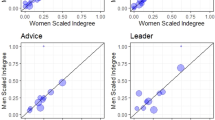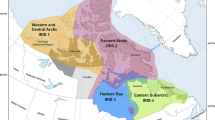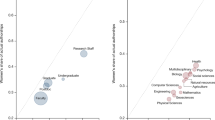Abstract
Within ice core science, woman-led studies contain 20% more women co-authors than man-led studies, and exceed the estimated proportion of women within the community by nearly 10%. We conclude that collaboration with other women is a key factor in closing gender gaps in science.
This is a preview of subscription content, access via your institution
Access options
Access Nature and 54 other Nature Portfolio journals
Get Nature+, our best-value online-access subscription
$29.99 / 30 days
cancel any time
Subscribe to this journal
Receive 12 print issues and online access
$259.00 per year
only $21.58 per issue
Buy this article
- Purchase on Springer Link
- Instant access to full article PDF
Prices may be subject to local taxes which are calculated during checkout



Similar content being viewed by others
Data availability
All underlying data are publicly available via GitHub at: https://github.com/mattosman/Ice-core-gender.
Code availability
All of the supporting code is publicly available via GitHub at: https://github.com/mattosman/Ice-core-gender.
References
Davies, S. W. et al. Promoting inclusive metrics of success and impact to dismantle a discriminatory reward system in science. PLoS Biol. 19, e3001282 (2021).
Van Dijk, D., Manor, O. & Carey, L. B. Publication metrics and success on the academic job market. Curr. Biol. 24, R516–R517 (2014).
Pico, T., Bierman, P., Doyle, K. & Richardson, S. First authorship gender gap in the geosciences. Earth Space Sci. 7, e2020EA001203 (2020).
Larivière, V., Ni, C., Gingras, Y., Cronin, B. & Sugimoto, C. R. Bibliometrics: global gender disparities in science. Nature 504, 211–213 (2013).
Bendels, M. H. K., Müller, R., Brueggmann, D. & Groneberg, D. A. Gender disparities in high-quality research revealed by Nature Index journals. PLoS ONE 13, e0189136 (2018).
Bernard, R. E. & Cooperdock, E. H. G. No progress on diversity in 40 years. Nat. Geosci. 11, 292–295 (2018).
Holmes, M. A., O’Connell, S., Frey, C. & Ongley, L. Gender imbalance in US geoscience academia. Nat. Geosci. 1, 79–82 (2008).
Wilson, C. E. Female Geoscience Faculty Representation Grew Steadily Between 2006-2016 (American Geosciences Institute, 2017).
Ford, H. L., Brick, C., Blaufuss, K. & Dekens, P. S. Gender inequity in speaking opportunities at the American Geophysical Union Fall Meeting. Nat. Commun. 9, 1358 (2018).
Holmes, M. A. et al. Does gender bias influence awards given by societies? Eos 92, 421–422 (2011).
Settles, I. H., Cortina, L. M., Malley, J. & Stewart, A. J. The Climate for Women in Academic Science: The Good, the Bad, and the Changeable 47–58 (Blackwell, 2006).
Hill, C., Corbett, C., St. Rose, A. & American Association of University Women. Why So Few? Women in Science, Technology, Engineering, and Mathematics (AAUW, 2010).
Ceci, S. J. & Williams, W. M. Understanding current causes of women’s underrepresentation in science. Proc. Natl Acad. Sci. USA 108, 3157–3162 (2011).
Dennehy, T. C. & Dasgupta, N. Female peer mentors early in college increase women’s positive academic experiences and retention in engineering. Proc. Natl Acad. Sci. USA 114, 5964–5969 (2017).
Van Der Wal, J. E. M., Thorogood, R. & Horrocks, N. P. C. Collaboration enhances career progression in academic science, especially for female researchers. Proc. R. Soc. B 288, 20210219 (2021).
Dansgaard, W., Johnsen, S. J., Møller, J. & Langway, C. C. One thousand centuries of climatic record from Camp Century on the Greenland ice sheet. Science 166, 377–381 (1969).
Ni, C., Smith, E., Yuan, H., Larivière, V. & Sugimoto, C. R. The gendered nature of authorship. Sci. Adv. 7, eabe4639 (2021).
Ross, M. B. et al. Women are credited less in science than men. Nature 608, 135–145 (2022).
Lerback, J. & Hanson, B. Journals invite too few women to referee. Nature 541, 455–457 (2017).
Hanson, B., Wooden, P. & Lerback, J. Age, gender, and international author networks in the Earth and space sciences: implications for addressing implicit bias. Earth Space Sci. 7, e2019EA000930 (2020).
Lewandowski, K. Pioneers in Antarctic research: Lois Jones and her all-woman science team explore the geochemistry of the Dry Valleys. In Women and Geology: Who Are We, Where Have We Come From, and Where Are We Going? (ed. Johnson, B. A.) (Geological Society of America, 2018).
Seag, M. Women need not apply: gendered institutional change in Antarctica and Outer Space. Polar J. 7, 319–335 (2017).
Kurtz, M. J. et al. The NASA astrophysics data system: Overview. Astron. Astrophys. Suppl. Ser. 143, 41–59 (2000).
Teele, D. L. & Thelen, K. Gender in the journals: publication patterns in political science. Polit. Sci. Polit. 50, 433–447 (2017).
Carrera, A., Luckie, T. & Cooperdock, E. H. Extreme underrepresentation of first-generation college students in the geosciences: an intersectional issue. J. Geosci. Educ. https://doi.org/10.1080/10899995.2023.2187233 (2023).
Cooperdock, E. H., Chen, C. Y., Guevara, V. E. & Metcalf, J. R. Counteracting systemic bias in the lab, field, and classroom. AGU Adv. 2, e2020AV000353 (2021).
Acknowledgements
We thank the 2022 Ice Core Early-Career Researchers’ Workshop (ICECReW), which had support from the US National Science Foundation, for inspiring this effort. We appreciate critical feedback from D. Verhoeven and H. Ewing, which strengthened and clarified the manuscript. We also thank M. Seag, who provided historical context on the US and British Antarctic programmes.
Author information
Authors and Affiliations
Contributions
B.G.K., M.O. and A.C. conceptualized the project. All authors contributed to data curation. M.O. developed the software, conducted the data analysis and visualized the data with input from B.G.K. B.G.K. and M.O. wrote the original draft, and all authors contributed to reviewing and editing the final manuscript.
Corresponding author
Ethics declarations
Competing interests
The authors declare no competing interests.
Peer review
Peer review information
Nature Geoscience thanks Tamara Pico and Suzanne O’Connell for their contribution to the peer review of this work.
Additional information
Publisher’s note Springer Nature remains neutral with regard to jurisdictional claims in published maps and institutional affiliations.
Extended data
Extended Data Fig. 1 Patterns in citation rate, coauthorship, and internationality by gender.
Distributions of women coauthors per study (top panel), citation rate per study (top middle), and number of unique nations per study (bottom middle) for man vs. woman-led studies, comparing the most recent decade of data (2012–2021) to the preceding ~four decades (1969–2011). The total number of studies analyzed for each grouping is also displayed in the bottom panel. Violin plots are shown as described in Fig. 2.
Extended Data Fig. 2 Proportion of studies led by women across leading ice core journals.
Dashed lines at left indicate gender parity (gray), and the estimated average community proportion of women during 1969–2011 (salmon) and 2012–2021 (red). Error bars indicate 95% confidence ranges based on Monte Carlo resampling (Methods). The top 21 journals that publish ice core research (which encapsulate approximately 90% of ice core contributions each year) are shown, listed from highest Impact Factor (top) to lowest Impact Factor (bottom). In the past decade, the proportion of woman-led studies in all top-21 journals has met or exceeded the estimated proportion of women in ice core science within 95% confidence, except for Science and Nature.
Rights and permissions
Springer Nature or its licensor (e.g. a society or other partner) holds exclusive rights to this article under a publishing agreement with the author(s) or other rightsholder(s); author self-archiving of the accepted manuscript version of this article is solely governed by the terms of such publishing agreement and applicable law.
About this article
Cite this article
Koffman, B.G., Osman, M.B., Criscitiello, A.S. et al. Collaboration between women helps close the gender gap in ice core science. Nat. Geosci. 16, 1088–1091 (2023). https://doi.org/10.1038/s41561-023-01315-y
Received:
Accepted:
Published:
Issue Date:
DOI: https://doi.org/10.1038/s41561-023-01315-y



